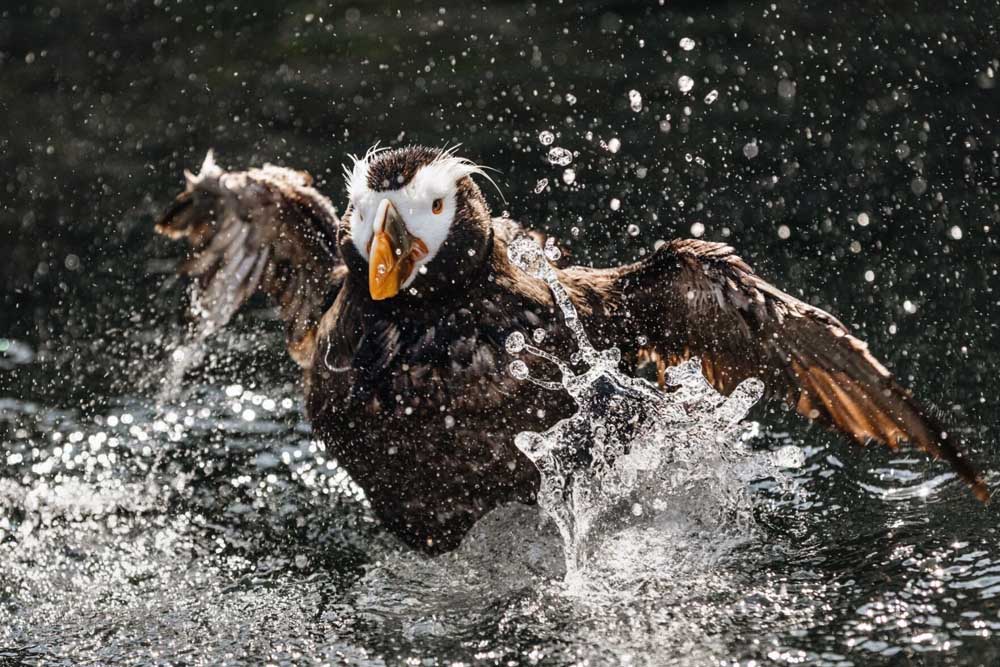Weekend Break: Puffins on the rock
Published 1:00 pm Friday, April 21, 2023

- "Water Dancer," a winning image in the 2022 Coast Weekend Photo Contest by Astoria resident Nathan Burton, captures a playful puffin at sea.
In spring, tufted puffins return from months of diving in the open ocean to Haystack Rock in Cannon Beach, where they nest, hunt for fish and mate throughout the summer.
To celebrate the puffins’ journey back from the sea, the Haystack Rock Awareness Program will host a series of interpretive programs throughout the birds’ nesting season. Viewing scopes, art programming and virtual lectures will lead off the season at an event from 8 to 11 a.m. Saturday and Sunday.
The idea is to give visitors a chance to learn about the puffins as they watch them go about their day.
‘Ambassador colony’
Haystack Rock, rising 235 feet from the shoreline of Cannon Beach, is a seasonal home to the largest onshore tufted puffin population in the continental United States.
“Haystack (Rock) is one of the most important, I would say, colonies here in Oregon, just because it’s the only accessible one by land,” Mylasia Miklas, a communications coordinator with the Haystack Rock Awareness Program, said. “So this tufted puffin colony can be a really good ambassador colony for the rest of the tufted puffin species, especially when we’re looking at advocating for protecting them.”
Puffins often nest on isolated, rocky islands far offshore, using soft sediment to burrow into layers of rock.
Because this sediment is found near the shore at Haystack Rock, birdwatchers in Cannon Beach have the rare chance to walk by the rock and view puffins outside of their burrows. Most offshore colonies are only accessible by boat.
The meadow
Puffins, Miklas said, will nest at the very top of the rock. It’s a part referred to as “the meadow,” a grassy area that slopes to the north and is a haven for birds. It’s filled with soft sediment, making for an ideal place to burrow or build a nest.
“Every year, they return to the same burrow,” Miklas said. “Every mating pair will go back to the same house every single year. And that’s also why sometimes the burrows can be around five to six feet deep.”
Miklas added that bird scoping stations, offering close-up views through binoculars and viewing scopes, are her favorite part of the group’s annual welcome event. “I love observing them, they’re super cute,” she said.
The morning hours, when scopes will be set up on the sand, offer a time window best for puffin watching. Light on the rock illuminates nesting areas and birds tend to be more active as they wake up and get ready to head out to sea. Their day consists of fish foraging for themselves and their baby puffins, known as pufflings.
For younger beachgoers on the lookout as they dive, interpretive stations on Saturday and Sunday morning will serve as bird tables, offering discoveries about the puffins. Miklas added that art stations at the event will allow kids to create puffin-themed projects.
A rare sight
Catching sight of the birds, even with powerful viewing scopes, is an experience growing less common by the year.
At Haystack Rock, the tufted puffin population has plummeted by 80% since 1980, from about 600 to 120 birds, according to the Haystack Rock Awareness Program. Habitat loss, pollution, an increased presence of bald eagles — a puffin predator — and declining numbers of fish have contributed to the population decrease.
Interpreters with the Haystack Rock Awareness Program aim to do just that, increase awareness by educating the public about the rock’s ecosystem. The program also partners with Friends of Haystack Rock, a group that advocates for funding to research the birds.
A recent donation from Friends of Haystack Rock, Miklas said, enabled her team to buy new bird-watching equipment for the upcoming puffin welcome event.
But the Haystack Rock Awareness Program’s education work extends beyond educating visitors about the puffin population.
When tide pools open seasonally, the program’s interpreters show people around the pools, answer questions and educate them on the importance of why Haystack Rock is protected as both a part of the Oregon Islands National Wildlife Refuge and by its status as a Marine Garden.
“Responsible exploration is definitely what we try to practice and try to teach people,” Miklas said. “Not only do we want them to, you know, take what they’re learning here, but we also want them to implement what they’ve learned from us while visiting Haystack if they’re visiting anywhere else along the coast.”
Puffin welcome event from 8 to 11 a.m. Saturday and Sunday at Haystack Rock
Interpretive programs during daytime low tides in Cannon Beach
www.haystackrockawareness.com






